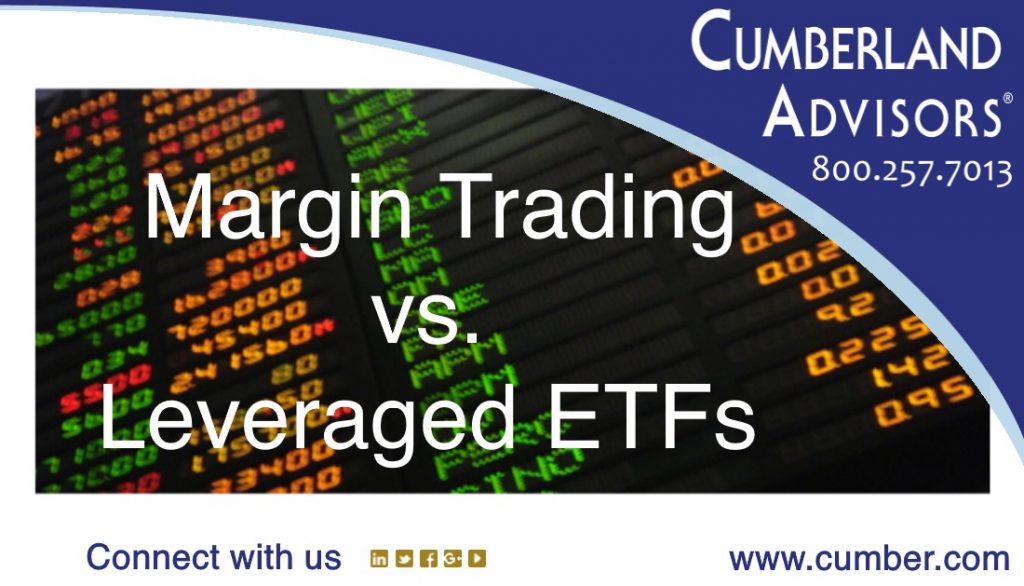Our previous commentary on leveraged ETFs (www.cumber.com/leveraged-etfs/) received many comments from our readers. We would like to thank you for sharing your thoughts and address one common question among many investors: Which is better, margin trading or leveraged ETFs?

First, what is the difference between these two methods of investing? We walked through leveraged ETFs last time, so we will focus mainly on margin trading today. Margin trading refers to borrowing funds from a broker in order to trade an asset such as stocks. The purpose of the loan is to amplify the gains on the invested position. However, margin trading is inevitably subject to the risk of substantial losses in the meantime. Hence, the purchased asset is also the collateral for the loan. Oftentimes, a broker allows an account to borrow up to 50% of the purchased price of a stock. The portion that is not borrowed funds is called the initial margin. A broker usually requires a minimum balance to be maintained in the account. This restriction is called the maintenance margin. If the account balance falls below the maintenance margin, your broker will send you a margin call and ask you to deposit funds to meet the requirement.
In a worst-case scenario, if an investor fails to deposit funds to meet the margin requirement, the broker can force-sell the investor’s stocks without notice. Margin liquidation is the main risk embedded in margin trading. Investors could lose 100% of their investment and possibly more by using margin. To demonstrate, we will use the example summarized in the table below. Assume we borrow 50% to purchase 100 shares of a stock at $100 a share, with a 6% interest rate, and ignore transaction costs. Hypothetically, the stock price goes down to $50 three months later. We are then left with zero equity and 100% debt. We also need to pay the interest on the loan to the broker, who will likely close the position if we fail to add any funds. If we don’t, we will lose 100% of our investment plus roughly 1.5% interest on the $10,000, for a total -101.5% return.

Table 1. Margin trading example – downside risk
What if we used a leveraged ETF and had the same stock movement? Although there is no ETF tracking just one stock, we will assume that there is, for the sake of simplicity. The short answer is that we would lose the 100% investment as the ETF fell to $0 per share. But we wouldn’t be subject to more than a 100% loss, as all ETFs incorporate the management fees into their NAVs.
After comparing the downside risk, now let’s take a look at the upside potential. Let’s assume the stock goes up to $150 after three months. The net return from margin trading would be 98.50%, as demonstrated below.

Table 2. Margin trading example – upside potential
If we used a leveraged ETF, the net return would be 2X the 50% return minus the 0.25% fee–about 99.75%. Hence, as long as the ETF fee is below the margin cost, leveraged ETFs have a competitive advantage over margin trading. Please note that for the purpose of demonstration the above example ignores the daily rebalancing effect, or “tracking error,” embedded in ETFs, as the performance of leveraged ETFs is path-dependent.
Beyond performance, there is something crucial yet often overlooked by investors. In the example shown in Table 2, we started by having 50% margin. However, as the stock price went up, our margin eventually fell to 1/3. Of course, we could continuously borrow more to maintain a 50% margin, but that would require constant rebalancing. In contrast to margin trading, leveraged ETFs maintain the targeted ratio continuously regardless of price movement. This effect is more pronounced in a bear market, as example 1 depicts. When stock prices plummet, investors tend to sell quickly to minimize their losses, exacerbating price declines. Meanwhile, investors are left owing more than the value of their stock positions and are likely to default on their margin loans. Moreover, lenders depend on the value of stocks as collateral. The cost of borrowing rises in a tumbling market, which in turn adds more pressure to margin trading.
Therefore, leveraged ETFs have the ability to achieve the same goal as margin trading while eliminating the margin call risk at potentially a lower cost. Compared to traditional margin, leveraged ETFs make it easier to maintain the targeted ratio. Leveraged ETFs are also better for short-term trading than margin, because it is easy to move in and out of a position. Last but not least, many leveraged ETFs have little liquidity risk, since this industry has grown to $80 billion in size in 2018 (source: https://www.reuters.com/article/investment-etf/leveraged-inverse-etfs-grew-to-record-in-january-etfgi-idUSL8N1QH4D0).
Leo Chen, Ph.D.
Portfolio Manager & Quantitative Strategist
Email | Bio
Links to other websites or electronic media controlled or offered by Third-Parties (non-affiliates of Cumberland Advisors) are provided only as a reference and courtesy to our users. Cumberland Advisors has no control over such websites, does not recommend or endorse any opinions, ideas, products, information, or content of such sites, and makes no warranties as to the accuracy, completeness, reliability or suitability of their content. Cumberland Advisors hereby disclaims liability for any information, materials, products or services posted or offered at any of the Third-Party websites. The Third-Party may have a privacy and/or security policy different from that of Cumberland Advisors. Therefore, please refer to the specific privacy and security policies of the Third-Party when accessing their websites.
Sign up for our FREE Cumberland Market Commentaries
Cumberland Advisors Market Commentaries offer insights and analysis on upcoming, important economic issues that potentially impact global financial markets. Our team shares their thinking on global economic developments, market news and other factors that often influence investment opportunities and strategies.

